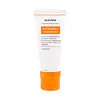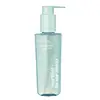What's inside
What's inside
 Benefits
Benefits

 Concerns
Concerns

 Ingredients Side-by-side
Ingredients Side-by-side

Water
Skin ConditioningPotassium Cocoyl Hydrolyzed Oat Protein
Skin ConditioningGlycerin
HumectantCocamidopropyl Betaine
CleansingPotassium Cocoyl Glycinate
PEG-120 Methyl Glucose Dioleate
EmulsifyingButylene Glycol
HumectantHippophae Rhamnoides Extract
MaskingXanthan Gum
EmulsifyingHouttuynia Cordata Extract
Skin ConditioningPanthenol
Skin ConditioningSodium PCA
HumectantDipotassium Glycyrrhizate
HumectantChlorphenesin
AntimicrobialAllantoin
Skin ConditioningDisodium EDTA
Capsicum Annuum Extract
MaskingDaucus Carota Sativa Extract
PerfumingWater, Potassium Cocoyl Hydrolyzed Oat Protein, Glycerin, Cocamidopropyl Betaine, Potassium Cocoyl Glycinate, PEG-120 Methyl Glucose Dioleate, Butylene Glycol, Hippophae Rhamnoides Extract, Xanthan Gum, Houttuynia Cordata Extract, Panthenol, Sodium PCA, Dipotassium Glycyrrhizate, Chlorphenesin, Allantoin, Disodium EDTA, Capsicum Annuum Extract, Daucus Carota Sativa Extract
Water
Skin ConditioningGlycerin
HumectantCocamidopropyl Betaine
CleansingPropanediol
SolventHydroxypropyl Bis-Hydroxyethyldimonium Chloride
HumectantSodium Methyl Cocoyl Taurate
CleansingSodium Benzoate
MaskingPanthenol
Skin ConditioningTrehalose
HumectantAcrylates/C10-30 Alkyl Acrylate Crosspolymer
Emulsion StabilisingXanthan Gum
EmulsifyingSodium Chloride
MaskingSaccharide Isomerate
HumectantAllantoin
Skin ConditioningPolyquaternium-39
Chlorphenesin
AntimicrobialGlyceryl Polyacrylate
Potassium Hydroxide
BufferingDisodium EDTA
Butylene Glycol
HumectantBetaine
HumectantSodium PCA
HumectantCitric Acid
BufferingSodium Citrate
BufferingSodium Lactate
BufferingPCA
HumectantHouttuynia Cordata Extract
Skin ConditioningSerine
MaskingAlanine
MaskingGlycine
BufferingGlutamic Acid
HumectantLysine Hcl
Skin ConditioningThreonine
Arginine
MaskingPentylene Glycol
Skin ConditioningBeta-Glucan
Skin ConditioningCaprylyl Glycol
EmollientProline
Skin ConditioningWater, Glycerin, Cocamidopropyl Betaine, Propanediol, Hydroxypropyl Bis-Hydroxyethyldimonium Chloride, Sodium Methyl Cocoyl Taurate, Sodium Benzoate, Panthenol, Trehalose, Acrylates/C10-30 Alkyl Acrylate Crosspolymer, Xanthan Gum, Sodium Chloride, Saccharide Isomerate, Allantoin, Polyquaternium-39, Chlorphenesin, Glyceryl Polyacrylate, Potassium Hydroxide, Disodium EDTA, Butylene Glycol, Betaine, Sodium PCA, Citric Acid, Sodium Citrate, Sodium Lactate, PCA, Houttuynia Cordata Extract, Serine, Alanine, Glycine, Glutamic Acid, Lysine Hcl, Threonine, Arginine, Pentylene Glycol, Beta-Glucan, Caprylyl Glycol, Proline
Ingredients Explained
These ingredients are found in both products.
Ingredients higher up in an ingredient list are typically present in a larger amount.
Allantoin is a soothing ingredient known for its protective and moisturizingg properties. Because of this, it is often added to products with strong active ingredients.
Studies show higher concentrations of this ingredient can promote wound healing.
Though it can be derived from the comfrey plant, allantoin is produced synthetically for cosmetic products to ensure purity.
Learn more about AllantoinButylene Glycol (or BG) is used within cosmetic products for a few different reasons:
Overall, Butylene Glycol is a safe and well-rounded ingredient that works well with other ingredients.
Though this ingredient works well with most skin types, some people with sensitive skin may experience a reaction such as allergic rashes, closed comedones, or itchiness.
Learn more about Butylene GlycolChlorphenesin is a synthetic preservative. It helps protect a product against bacteria in order to extend shelf life. In most cases, Chlorphenesin is paired with other preservatives such as phenoxyethanol and caprylyl glycol.
Chlorphenesin is a biocide. This means it is able to help fight the microorganisms on our skin. It is also able to fight odor-releasing bacteria.
Chlorphenesin is soluble in both water and glycerin.
Studies show Chlorphenesin is easily absorbed by our skin. You should speak with a skincare professional if you have concerns about using Chlorphenesin.
Learn more about ChlorphenesinCocamidopropyl Betaine is a fatty acid created by mixing similar compounds in coconut oil and dimethylaminopropylamine, a compound with two amino groups.
This ingredient is a surfactant and cleanser. It helps gather the dirt, pollutants, and other impurities in your skin to be washed away. It also helps thicken a product and make the texture more creamy.
Being created from coconut oil means Cocamidopropyl Betaine is hydrating for the skin.
While Cocamidopropyl Betaine was believed to be an allergen, a study from 2012 disproved this. It found two compounds in unpure Cocamidopropyl Betaine to be the irritants: aminoamide and 3-dimethylaminopropylamine. High-grade and pure Cocamidopropyl Betaine did not induce allergic reactions during this study.
Learn more about Cocamidopropyl BetaineDisodium EDTA plays a role in making products more stable by aiding other preservatives.
It is a chelating agent, meaning it neutralizes metal ions that may be found in a product.
Disodium EDTA is a salt of edetic acid and is found to be safe in cosmetic ingredients.
Learn more about Disodium EDTAGlycerin is already naturally found in your skin. It helps moisturize and protect your skin.
A study from 2016 found glycerin to be more effective as a humectant than AHAs and hyaluronic acid.
As a humectant, it helps the skin stay hydrated by pulling moisture to your skin. The low molecular weight of glycerin allows it to pull moisture into the deeper layers of your skin.
Hydrated skin improves your skin barrier; Your skin barrier helps protect against irritants and bacteria.
Glycerin has also been found to have antimicrobial and antiviral properties. Due to these properties, glycerin is often used in wound and burn treatments.
In cosmetics, glycerin is usually derived from plants such as soybean or palm. However, it can also be sourced from animals, such as tallow or animal fat.
This ingredient is organic, colorless, odorless, and non-toxic.
Glycerin is the name for this ingredient in American English. British English uses Glycerol/Glycerine.
Learn more about GlycerinHouttuynia Cordata Extract is more commonly known as Heart Leaf, Fish Mint, or Chameleon plant.
The components found in Heart Leaf give it antioxidant, hydrating, antimicrobial, and anti-inflammatory properties.
Heart Leaf is rich in flavonoids such as quercetin, apigenin, and more. It also contains polysaccharides, the most common type of carbs in food.
Flavonoids have been shown to be effective antioxidants. They help neutralize free-radical molecules. Free-radical molecules are unstable molecules that may damage our skin cells and DNA. The flavonoids in Heart Leaf also help soothe the skin.
Polysaccharides are naturally found in our skin. They play a role in hydrating and repairing the top layer of skin. The polysaccharides in Heart Leaf help moisturize our skin.
Studies show decanoyl acetaldehyde, a component of Heart Leaf oil, is effective at killing bacteria.
The name 'Fish Mint' comes from the herb's natural fishy smell. Is is native to southeast Asia and used throughout the continent for traditional cooking and medicine.
Learn more about Houttuynia Cordata ExtractPanthenol is a common ingredient that helps hydrate and soothe the skin. It is found naturally in our skin and hair.
There are two forms of panthenol: D and L.
D-panthenol is also known as dexpanthenol. Most cosmetics use dexpanthenol or a mixture of D and L-panthenol.
Panthenol is famous due to its ability to go deeper into the skin's layers. Using this ingredient has numerous pros (and no cons):
Like hyaluronic acid, panthenol is a humectant. Humectants are able to bind and hold large amounts of water to keep skin hydrated.
This ingredient works well for wound healing. It works by increasing tissue in the wound and helps close open wounds.
Once oxidized, panthenol converts to pantothenic acid. Panthothenic acid is found in all living cells.
This ingredient is also referred to as pro-vitamin B5.
Learn more about PanthenolSodium PCA is the sodium salt of pyroglutamic acid. It is naturally occurring in our skin's natural moisturizing factors where it works to maintain hydration.
The PCA stands for pyrrolidone carboxylic acid, a natural amino acid derivative.
This ingredient has skin conditioning, anti-inflammatory, and humectant properties. Humectants help hydrate your skin by drawing moisture from the air. This helps keep your skin moisturized.
Learn more about Sodium PCAWater. It's the most common cosmetic ingredient of all. You'll usually see it at the top of ingredient lists, meaning that it makes up the largest part of the product.
So why is it so popular? Water most often acts as a solvent - this means that it helps dissolve other ingredients into the formulation.
You'll also recognize water as that liquid we all need to stay alive. If you see this, drink a glass of water. Stay hydrated!
Learn more about WaterXanthan gum is used as a stabilizer and thickener within cosmetic products. It helps give products a sticky, thick feeling - preventing them from being too runny.
On the technical side of things, xanthan gum is a polysaccharide - a combination consisting of multiple sugar molecules bonded together.
Xanthan gum is a pretty common and great ingredient. It is a natural, non-toxic, non-irritating ingredient that is also commonly used in food products.
Learn more about Xanthan Gum